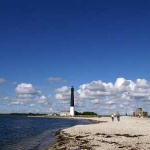Sights Saaremaa, Estonia
 Sõrve lighthouse is located on the Sõrve peninsula at the entrance to the Strait of Irbe. From here you can see the coast of Latvia. Perhaps that is why this cape is very popular with tourists in Latvia. Syrvesaar was once an island, separated from the Strait of Saaremaa. Some historians consider it likely that the origin of its name from the Estonian words serv (sorv), meaning "edge, the limit. There is also a view that was the original name Sworbe or Swarbe, meaning in the Estonian language "hoof", and given it the island because of its similarity in shape to the hoof.
Sõrve lighthouse is located on the Sõrve peninsula at the entrance to the Strait of Irbe. From here you can see the coast of Latvia. Perhaps that is why this cape is very popular with tourists in Latvia. Syrvesaar was once an island, separated from the Strait of Saaremaa. Some historians consider it likely that the origin of its name from the Estonian words serv (sorv), meaning "edge, the limit. There is also a view that was the original name Sworbe or Swarbe, meaning in the Estonian language "hoof", and given it the island because of its similarity in shape to the hoof.Kuressaare Bishop Castle - a Gothic fortress of the XIV century, one of the oldest in the Baltic, is really worth it to see her. The castle is the "lion's pit, where, as legend has it, Bishop threw his enemies.
Kaali meteorite crater - 100-meter crater left by a meteorite, and called "the grave of the sun." Scientists argue about the fall of the meteorite: some believe that this event occurred 2400 years ago, others - 7500 years ago.
Windmills - tireless "windmills" - also a local landmark. Saaremaa is still quite a lot of windmills. And in the town in England, that in the northern part of the island, five of them at once. Here and pole mills (all of them top the wind turns around its axis), and the Dutch, who have only swirling blades.
At the ostrich farm on the island of Muhu, you can see and feed the largest flightless birds - African ostriches, South America - rhea, Australian emus and kangaroos. If possible, you can arrange at the expense of a picnic. In a small shop you can buy an ostrich egg, meat and leather products.